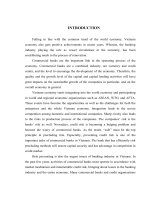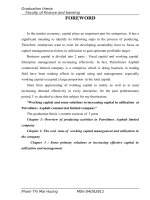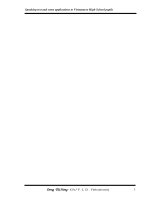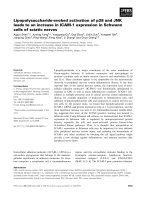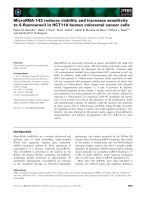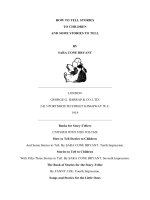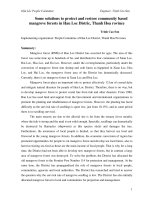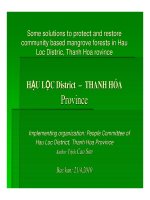Working capital and some solutions to increasing capital in utilization at Petrolimex Asphalt commercial limited company
Bạn đang xem bản rút gọn của tài liệu. Xem và tải ngay bản đầy đủ của tài liệu tại đây (263.67 KB, 37 trang )
CONTENTS
FOREWORD.......................................................................................................1
CHAPTER 1
THEORY OF WORKING CAPITAL AND ITS EFFECTIVE
UTILIZATION IN ENTERPRISE....................................................................2
1.1. Theory of working capital ......................................................................2
1.1.1. The notion of working capital ............................................................2
1.1.2.Working capital and the classification ................................................3
1.1.3. Working capital’s structure and driving factors behind .....................4
1.1.4. Working capital resources ..................................................................4
1.1.5.Working capital demand and the driving factors behind ....................5
1.2. Working capital and its importance in increasingly effective
utilization..........................................................................................................6
1.2.1. Working capital and norms to reflect its cycle speed .........................6
1.2.2. The main factors have influences on the utilization effects of working
capital ...........................................................................................................8
1.2.3. Some solutions aiming to increase the utilization effects of working
capital ...........................................................................................................9
CHAPTER 2
THE REAL STATE OF WOKING CAPITAL MANAGEMENT AND
UTILIZATION IN THE COMPANY.............................................................10
2.1. Overview of producing activities in Petrolimex Asphalt commercial
limited company............................................................................................10
2.1.1. Back ground and developing process................................................10
2.1.2. Business sectors and main products..................................................10
2.1.3. Organization of management ..........................................................11
2.1.4. Accounting’ s structure ..................................................................11
2.2. The real state of working cappital’s utilization at Petrolimex Asphalt
commercial limited company ......................................................................14
2.2.1. Overview of assets and capital resources of the company ...............14
2.2.2. The real situation of working capital’s utilization at the company . .16
2.2.3. In summary........................................................................................26
CHAPTER 3
SOME SOLUTIONS TO INCREASING EFFECTIVE OF WORKING
CAPITAL IN MANAGEMENT AND USTILIZATION AT
PETROLIMEX ASPHALT COMMERCIAL LIMITED COMPANY.......27
3.1. Advantages and challenges in operation of the company ..................27
3.1.1. Advantages........................................................................................27
3.1.2. Challenges.........................................................................................27
3. 2. Oriented developing of the company in the coming years ................27
Pham Thi Mai Huong
MSV:04D02811
3.3. Some primary sollutions to improve the effective utilization of
working capital .............................................................................................28
3.3.1. Actively work out plans in mobilising and using working capital
efficiently.....................................................................................................29
3.3.2. Push up effectively the use of cash capital and specify clearly
resonable reserves .......................................................................................30
3.3.4. To strengthen investment and enlarge market to push up goods
consumption. ..............................................................................................31
3.3.5. Investment satandar to workers and officials....................................32
3.3.6. Other solutions...................................................................................33
CONCLUSIONS................................................................................................34
Pham Thi Mai Huong
MSV:04D02811
FOREWORD
In the market economy, capital plays an important part for enterprises. It has
a significant meaning to identify its following steps in the process of producing.
Therefore, enterprises want to exist for developing sustainably have to focus on
capital management activities in utilization to gain optimum profitable target.
Business capital is divided into 2 parts : Fixed capital and working capital.
Enterprise management in increasing effectively. In fact, Petrrolimex Asphalt
commercial limited company is a enterprise which is doing business in trading
field have been making efforts in capital using and management, especially
working capital occupied a large proportion in the total capital.
Stem from appreciating of working capital in reality as well as to meet
increasing demand effectively in every enterprise, for the past probrationary
period, I’ve decided to chose this subject for my thesistation.
“Working capital and some solutions to increasing capital in utilization
at Petrolimex Asphalt commercial limited company”
The graduation thesis’s content consists of 3 chapters :
Chapter 1 :The theology of woking capital and woking capital’s effects in
enterprises.
Chapter 2 : The real state of working capital management and utilization
in the company
Chapter 3: Some main solutions to increasing the effects of woking capital
in utilization and management
1
CHAPTER 1
THEORY OF WORKING CAPITAL AND ITS EFFECTIVE
UTILIZATION IN ENTERPRISE
1.1. Theory of working capital
1.1.1. The notion of working capital
Any enterprise wants to carry out its produce and business process, it needs a
combination of 3 factors : labour force, tools and materials
Difference between tools for working and materials for working
(materials, fuels, semi- unfinished products
…). It only take part in one
producing process and does not come back its initial form, all its value will
change into in product’s value.
Materials for working : as in kind form it is called working assets. As for
value form, it is called Working capital of enterprise.
Working Assets included : Working assets for manufactoring and
working capital for circulating.
Working Assets for manufactoring included such as : raw materials, fuels,
materials, alternative accessories, half of products, unfinished products … are all
being in process of reserve or manufactoring.
Working Assets for circulating included : finished products are waiting
for consumption, capitals in cash, capitals in payment, prepaid costs … In
producing and businessing process, working Assets for manufactoring and
working assets for circulating are always mobilising, transforming to each other
and at last aiming to ensure non-stop produce and business process.
It is also an expressed form of working assets, so the characters of
working capital exercises are always affected by working assets’s characters.
Working capital will be transformed and repeated consecutively. So, they will
create repeated cycle of working capital. One cycle starts since investing capital
under the monetory form then finishing at the production cycle to come back its
initial state.
2
To the manufacture enterprises, the cycle of working capital process
always mobilises under the following formula :
Manufacturing materials
C-G
Manufactoring object
… Produce … G’- C’
Labour
For commercial enterprises, the repeated cycle of working capital process
always mobilises under the following formula :
C– G – C’
Therefore, Working capital is under the monetory, it is an expressed form
of working capital or in other words, it is monetory on prepaid account to take
shape of working assets for producing and working assets for circulating to
ensure process of produce and business are going on smoothy.
1.1.2.Working capital and the classification
1.1.2.1. The classification under expressed form
According to the classification, working capital is divided into 2 parts :
- Capital in cash and accounts receivable : It consists of monetory in
funds, bank’s deposit, capital in payment, short-term investment in securities …
- Capital in materials, goods : They are working capitals which are under
the expressed forms such as raw materials and materials, unfinished products,
semi-finished products, finished products …
The classification will help enterprises to evaluate the level of inventory
and ability of payment.
1.1.2.2. The classification under the working capital’s role in produce and
business process
Under the classification, working capital are divided into 3 parts :
- Working capital in producing reserved : Including of prime materials,
sub materials, fuels, alternative marterials, tools.
- Working capital in producing process : Value of unfinished products,
semi-finished products and other costs.
3
- Working capital in circulating process : Value of finished products,
capital in cash, short-term investment, mortgages, pay a security, pay earnest
money in short-term and accounts capital in payment.
1.1.3. Working capital’s structure and driving factors behind
There are many factors that have influences on capital’s structure, including
many parts. There can be divided into 3 main groups below :
- The factors related to supply materials such as : The distance between
enterprise and supplier places, market and ability of supply materials, material
prices, the scale of production.
- The factors related to production : Character, technology, producing
technology of the enterprise, the complexion of produced products, the lengh of
produce cycle, the level ability of producing process organization, professional
skills of Workers.
- The factors related to payment method : payment methods and the
execution of payment principles between enterprises.
1.1.4. Working capital resources
1.1.4.1. The classification with the relation of ownership
According to the classification, it is divided into 2 parts :
- Loan Accounts : It is the capital resource of borrowing from commercial banks
or financial organizations, Customer ccounts receivable....enterprise is entitled
to use them in a given temporary .
- Owner’s equity : This is account capital which is under enteprise ownership,
including
* Mobilised capital inside : left benefit, funds.
* Mobilised capital outside : From the members of enterpsie, joint-venture
capital, State budget capital, Share capital is mobilised by issuing shares to the
public.
4
1.1.4.2. Classification of working capital following to mobilising time and
utilization methods
According to the norm, enterprises’working capital included : regular
capital and current capital.
- Regular capital : Including the Owner’s equity and long-term debts. The
capital is stable and can use for along time. Enterprises use it for investment,
buying Fixed assets or using all or part of regular working capital which is
necessary for business activities.
- Current capital : Including of short-term loans from banks and other
credit organizations, long-term debts fall due, Accounts receivable from
suppliers, Accounts payable for workers, Accounts payable for the State budget
… This is short term capital that enterprise can use it to meet the temporary
working capital demand in produce and business activities.
The classification will help managers to evaluate the mobilised capital
which is suitable to quality and in the time to use necessary factors for business
activities.
1.1.5.Working capital demand and the driving factors behind
Working capital demand always changes and depend on many factors. In
there, we need to care about following the fomula and the main factors :
capital
Suppli
Custo
Working
=
Inventories
+
mer accounts
receivable
demand
-
ers accounts
prepaid
- The factors related to Business features such as : Business period,
Business scale, it is temporary Business activities, The changes of producing
technology … The factors have affected directly to the level of working capital
that enterprise has to meet the prepaid capital with a required time demand.
- The factors related to buy materials and product consumption :
+The distance between enterprises and suppliers.
5
+ The fluctuations of goods and material costs which are being used in
produce and business of the enterprises.
+ The gap between enterprises and selling market .
+ Conditions and means of transportation …
- Enterprise’s policies in consumption activities and credit with payment
organization impact on payment term and scale of Accounts receivable.
Consumption activities organization and carry out the payment activities
organization of selling goods have strongly affected to enterprise’s working
capital demand.
1.2. Working capital and its importance in increasingly effective
utilization.
1.2.1. Working capital and norms to reflect its cycle speed
1.2.1.1. Payment ratios
* Short-term debts payment ratio
It is the relation between short-term assets and short-term debts
( including: short-term debts in term and long-term debts fall due ).
Value of current aassets
The current ratio = –––––––––––––––––––––––––––
Short-term debts
This ratio assesses changeable ability of short-term assets into cash in order
to pay Short-term debts in term of Enterprises.
Short term Assets = Inventories + Cash and equivalent + Accounts receivable.
Among them, Inventories is a part of working capital which has the lowest
ability to change into monetory.
* Quick ratio
Value of current assets – Value of Inventories
The quick ratio = –––––––––––––––––––––––––––––––––
Short-term debts
6
This ratio reflects accounts debts in the fastest time.This ratio provides
information regarding the firm’s liquidity and ability to meet its obligations. It
indicates a company financial strenghts (or weaknesses) but this ratio can be
good or bad, this depends on character of every business field.
* The cash ratio
Cash and cash equivalent
The cash ratio = –––––––––––––––––––––––––––––––––
Short-term debts
The cash ratio measures whether or not a firm has enough resources to pay its
debts over the nest 12 moths. It compares a firm’s current assets to its current
liabilities.
A comparison with the industry of the firm’s current ratio, and a
comparison with average, can help determine if the current ratio is high or low
at this period in the time’s comparison. These comparisons do not indicate why
the current ratio is higher or lower than industry. For some possible reasons of
the current ratio is out of line, which can be found from analysis of the
individuals account that has been usually performed for Accounts receivable and
Inventories.
1.2.1.2. The number of Inventory cycle
The number of inventory cycle are the times of average inventory, which
is mobilised in term.
Costs of goods sold
The number of inventories cycle = ––––––––––––––––––––––––
Average Inventories
The number of inventory cycles are more and more higher, the business
will be better because enterprises only need to invest a small level of
Inventories but they still achieve a high turnover.
1.2.1.3.The number of accounts receivable cycle
7
The norm reflects ability of capital recovery for payment in enterprises
Accounts receivable
cycle
=
Net Sales
Remainder average Accounts receivable
The cycle is more higher, the more better. It proves that the fast speed of
recovery of Accounts receivable. Enterprises will needn’t to invest too much in
Accounts receivable.
1.2.2. The main factors have influences on the utilization effects of working
capital
* Objective factors
+ Fluctuations of economy : If economy with its inflation causes the
rising of goods prices, including input material costs, produce costs will grow,
product prices will be raised and of course to make the consumption will
become ineffciently.
+ The non-stop development of Science and Technology also contribute
to increasing effecient utilization of working capital. Science and technology
are developing that it can be helpful factors or can be adverse factors to
enterprise.
if enterprise produces redundant products and they can not be
consumed. Therefore this will be negative factors.
+ Business environment : The number of rising competitors, alternative
products, changed market demand … They will impact on the ability of
consumption, even though leading to the situation of capital losing.
+ The State with marcro policies : The state’s policies are very important
to enterprises’ operations. In each policy has 2 effects, may be positive and may
be not positive to Business activities in their fields.
* Subjective factors
+ We can recognize enterprises’ weak points in quality of management. It
causes the redundant or shortage of capital.
8
+ Ability of penertration and enlargement the market of enterprise : the
speed of consumptionis better, the Working capital is higher, therefore its
efficient in utilization will grow.
1.2.3. Some solutions aiming to increase the utilization effects of working
capital
1.2.3.1. Specification of the level necessary working capital demand for
business operation
Specification of necessary working capital regularly, this will ensure the level
enough capital to meet the demand of business process amd avoid unliquided
capital or short of capital, leading to interrupted production situation.
Business activities have to ask for capital to come into operation. When starting
to produce and do business, enterprise has to calculate the level of necessary
capital demand and one of the most important is that enterprise has to calculate
accurately in line with developing period in general and in produce process in
particular. Because of this will help enterprise’s business operation go on
smoothy and efficiently.
1.2.3.2. To push up the working capital’ s rotate speed highly
The effects of working capital are evaluated by its rotate speed. If
working capital has a highly rotated speed, it shows that the effects of working
capital utilization are very good. So, it is necessary to hasten speed of liquided
working capital in 3 processes : reserve , produce and circulation.
1.2.3.3. Carry out of checking, analysing, surpervising business activities tightly
and regulary.
Executing of check activities regularly and consecutively will help
enterprises to evaluate their strong points and weak points. Steming from there,
enterprises can develop their advantages or prevent and modify shortcomings in
time.
9
CHAPTER 2
THE REAL STATE OF WOKING CAPITAL MANAGEMENT AND
UTILIZATION IN THE COMPANY
2.1. Overview of producing activities
in Petrolimex Asphalt
commercial limited company
2.1.1. Back ground and developing process
Enterprise name : Petrolimex Asphalt commercial limited company
Short name
: Petrolimex Asphalt co.,LTD
Headquarters
: At 1 Kham Thien _Dong Da district _ Ha Noi
Petrolimex
asphalt
commercial
limited
company,
to
be
a
subsidiary of Petrolimex Petrochemical - a member of Viet Nam
Petrolimex, head of company. The company specialises in business with
products related to asphalt in domestic market and regional South East
Asia countries.
In order to meet the increasing demand of petrolimex asphalt products in the
domestic market. The ministry of Trading officially approved the company
became as a member of Petrolimex Petrochemical joint stock company and
under the name of Petrolimex Asphalt commercial limited company. The
company deloyed “under the model of parents _subsidiary company ”.
PLC is one of the most dynamic members of Petrolimex Petrochemical and
approved by the ministry of Trading.
Presently, the company is representative partner of BPETCO to supply
high quality products of BP on market. It has been the first doing business with
60/70 hot solid asphalt products in Viet Nam since 1997
2.1.2. Business sectors and main products
Do business sectors
Do business with import and export petrolimex Asphalt products, in the
short term, concluded 3 main sectors : lubricant , chemical, asphalt fields and
some sectors related to them.
- Doing business with import and export material products, Asphalt equipments.
10
- Doing business with services related to : Shipping, stocks, mixtrure,
alnalysis, consultancy and technical services.
- In the coming time, the company will take part in doing business with
buildings and real estate.
Main products : Asphalt, chemical, lubricant.
2.1.3. Organization of management
Management’ structure : Including, chairman, director, duty director .
- Chairman: cotrol Business activities as well as making regulations,
priciples and the organization model and and have the authority to appoint
director of Petrolimex Asphalt limited company.
- Director : Director is a person who is resposible for Business operations to
chairman and directly running Business activities and has to report them to
chairman.
- Vice director : vice director is a person who is intitled to help director and
along with director to run Business operations and to take the regulations and
priciples of mother company given into practice. Duty director is also
responsiblity to director and chairman for given responsibility.
2.1.4. Accounting’ s structure
Accounting department : responsible to financial accounting activities to
director. Always updating and giving accurated figures in time. The department
has to give balance sheet, financial report … calculate expensives such as :
profits, make loss, taxes, salary, bonus, other policies for staffs.
At the being time, accounting department has 9 people concluded : 1 chief
accountant, 2 deputy chief accountants and 6 accountants (accountant take
resposible for the whole company, accountant for departments, accountant for
details). They are all up to the standard of graduated University.
11
Accounting’s structure
Sales
Accountant
Deputy
accountant
about
General
Payment
Accountant
Chief
Accountant
Internal
audit
Fixed assets
Accountant
Deputy
accountant
about tax
and finance
statement
Cash
Accountant
Salary
Accountant
12
Management organization
CHAIRMAN
DIRECTOR
DEPUTY DIRECTOR
General
Management
department
Finance and
accounting
department
Quality
center
department
Asphalt
business
department
Branches
Container depots
HAI PHONG
THUONG LY
ĐA NANG
NAI HIEN
SAI GON
QUY NHON
CAN THO
NHA BE
TRA NOC
13
2.2. The real state of working cappital’s utilization at Petrolimex
Asphalt commercial limited company
2.2.1. Overview of assets and capital resources of the company
Look at the table 1in the next pageet assets and capital resources of the
company was higher than last year because of extending lager scale of produce
and business .
Within 2 years of 2006 and 2007 current assets of the company accouted for a
high ratio in the number of assets. Namely, in 2006 it was 93.2% and 94.1% in 2007
among of all assets value which made the company’s fixed capital had only small
density in structure of assets. For example, in 2006 it occupied 6.8% and reduced
5.9% in 2007. This structure is entirely reasonable in line with enterprises doing
business in trading. It proved that the current assets’s impotance and the floating
of working capital has a great meaning for the company in utilization and
management because if the company does not use it effectively, leading to the
company has to borrow money from credit organizations even this way or that
way it is not good for the company.
As for capital resourse, the company tended to use loans. In 2006 the
Accounts payable of 43.8% density and decreased slightly 42.1% density in
2007. Although reduced, it was still high in the total of the company’s capital.
Owner’s equity accounts for a small density in capital resource structure of the
company such as 12.4% and 15.7% in 2007.
Business capital is an value expression of assets. It included : Working
capital, it is a form of its value and short term investment accounts; Fixed capital
is an expression of its value and long term investment. Looking at business capital
structure, showed that the business capital increased with high speed, the company
was expanding for a larger scale to control the market, namely : In 2006, business
capital 954.698.725 thousand dongs. Its value growed 199.592.549 thousand dongs
and present at 1.154.291.274 thousand dongs. It increased relatively of high speed,
equivalent of 20.1%.
14
Graduation thesis
Faculty of finance and banking
Table 1 : Structure of assets and resources
Year
Order
2006
2007
Value
1
Density
(%)
Value
Density
(%)
2
3
4
5
( Unit : thousand dongs )
2007/2006
Ratio
Density
Value
dispropotion dispropotion
dispropotion
(+-%)
(+-%)
6=4-2
7 =6/2
8=5-3
A
Assets
954.698.725
100
1.154.291.274
100
199.592.549
20.1
0
I.
Current assets
889.722.443
93.2
1.086.641.876
94.1
186.919.433
21
0.9
II.
Fixed assets
64.976.282
6.8
67.649.398
5.9
2.673.116
4.11
-0.9
B
Total capital
1.697.874.829
100
1.994.437.888
100
296.563.059
17.4
0
I.
Liabilities
743.176.105
43.8
840.146.614
42.1
96.970.509
13.04
-1.7
1.
Short term debt
742.674.439 43.7
839.452.516
42.1
96.778.077
13.03
-1.6
2.
Long term debt
501.665
0.1
694.097
0.1
192.432
38.35
0
II.
Owner’s equity
211.522.620
12.4
314.144.661
15.7
102.622.041
48.51
3.3
(source of Accounting department at PLC)
Pham Thi Mai Huong
15
MSV:04D02811
Graduation thesis
Faculty of finance and banking
To get the good results of growing business capital above, the company
used flexibly its financial resources included Owner’s equity and Accounts
payable. In 2006, Accounts payable were 743.176.105 thousand dongs, holding
43.8% in the total capital. Owner’s equity was 211.522.620 thousand dongs,
equivalent of 12.4 % in the total capital. In 2007, the scale of capital was
increased both of Accounts payable and working capital : Accounts payable
raised 96.970.509 thousand dongs, equivalent of 13.04% ratio. Meawhile, Its
owner’s equity speed of 48.51%, equal to 102.622.041 thousand dongs. This
showed that, the rising rate of Owner’s equity was higher than Accounts payable
in 2007, leading to ratio of capital resource changed, Owner’s equity increased
by 48.51 % and Accounts payable reduced to 42.1%. Although, the density of
loans reduced but accounted for a large propotion of total capital. The structrure
of the capital required to execute activities of management and use it efficiently.
Because of business character, short term debt hold nearly entire in 2006
and 2007. Long term obligation grew 192.432 thousand dongs, equal to 38.35%.
Short term debt occupied over high rate, under which the company has to set
plans to accomplish its accounts debt within required time, it would help the
company to guarantee its prestige in payment.
2.2.2. The real situation of working capital’s utilization at the company
2.2.2.1.Working capital’s structure
Working capital plays a vital part in the company since taken shape,
especially to enterprises which have activities in business trading, working
capital always account for high ration in all business capital. Therefore, structure
of working capital in every company which is doing business in trading such as
Petrolimex Asphalt limited company, it would impacted
on its results of
processing line and business activitives.
Look at the table 2, capital’s structure of PLC, we find out its Working
capital scale in 2007 increased 223.080.993 thousand dongs higher than 2006,
Pham Thi Mai Huong
16
MSV:04D02811
Graduation thesis
Faculty of finance and banking
equal to 25%. It included 3 component parts : Cash capital, Inventories,
Accounts receivable, almost all was increasing in value.
The density of capital in cash moved up in 2007 compared to 2006, which
pushed ability of payment for the company. Working capital has been driven,
caused by cash and bank deposits were all increased. In contrast, the density of
them were all reduced from 15.1% to 13.5%, which showed that the company had
a tendency to decrease the density of availabe cash funds in order to increase the
effective utilization of capital. So, the company should consider exactly the level
of a reasonable cash reserve. Avoiding situations of being over lack or redundant
cash funds.
Accounts receivable were over high, following that it would reduce ability
of making profits, then capital could not liquidized continuously, even
unnecessary costs could be raised related to the management activities of
recovering capital costs … Customer accounts receivable played a majority in
accounts receivable. Thus, the company really needs good measures to manage
and recover it in dated time in order to avoid bad accounts debts which could be
leading to lose its capital.
Inventory capital was more and more higher because of enlarging its
scale. Requiring the company should have big goods reserve levels to meet the
huge contracts demand in time under which would help it make a good image.
We realised that almost all of goods were imported, so every time in import is
a process leading to increasing the cost of time and money. Therefore, the
company always has enough goods in stock to meet the selling demand and
avoid situations goods out of stock which could impact on the company’s
prestige. Howerver, over redundant Inventories would raise costs of storage,
keeping in good condition and capital unliquidized … So the company shoud
canculate the level inventory reserves accurately and namely.
Pham Thi Mai Huong
17
MSV:04D02811
Graduation thesis
Faculty of finance and banking
Table 2: Structure of current Assets
Order
I.
1.
2.
II.
1.
2.
3.
4.
III.
1.
2.
3.
4.
5.
IV
Contents
1
Cash and cash equivalent
Cash funds
Bank`s deposits
Accounts receivable
Customer accounts
receivable
Supplier Prepaid accounts
Other accounts receivable
Spare bad accounts
receivable
Inventories
Raw materials
Tools
Finished products
Goods
Prepaid accounts short term
Total curent assets
Pham Thi Mai Huong
Value
2006
2
85.710.401
12.936.301
72.774.100
466.350.212
Density
(%)
Value
2007
Density
(%)
Value
dispropotion
Ratio
dispropotion
(+-%)
7 =6/2
31.9
17.9
34.4
17.1
Density
dispropotion
(+-%)
8=5-3
0.8
-1.6
1.6
-4.6
3
9.6
15.1
84.9
52.4
4
113.046.853
15.256.785
97.790.068
546.526.839
5
10.4
13.5
86.5
47.8
6=4-2
27.336.452
2.320.484
25.015.968
80.176.627
467.598.807 100.2
545.326.874
104.6
77.728.067
16.6
4.4
10.789.501
17.861.692
2.3
3.8
11.532.854
20.064.879
2.1
3.9
743.353
2.203.187
6.8
12.3
-0.1
0.1
-29.899.788
-6.3
-30.397.768
-10.7
-497.980
1.6
-4.4
337.661.825
90.164.219
2.537.148
65.597.684
177.208.367
2.154.407
889.722.438
38
26.7
0.7
19.4
52.4
0.8
100
453.229.739
124.791.630
3.687.977
88.697.145
232.874.985
3.178.002
1.112.803.431
41.8
27.5
0.8
19.5
51.5
0.7
100
18
115.567.914
34.2
3.8
34.627.410
38.4
0.8
1.150.829
45.3
0.1
23.099.461
35.2
0.1
55.666.618
31.4
-0.9
1.023.595
47.5
-0.1
223.080.993
25
0
(source of Accounting department at PLC )
MSV:04D02811
Graduation thesis
Faculty of finance and banking
2.2.2.2. The situation of management in ability of payment
Capital in cash of management
Ability of payment increased by the growth of cash and bank deposits but
the major factor is caused of influence on the rise of bank deposits.
- Cash funds was up 2.320.484 thousand dongs, equivalent of 17.9% rate
but decreased 1.6% density.
- The company is an enterprise, doing business in the field of trading by
import and export operation. So the payment activities were finished at the bank.
It is easy to understand that the bank deposits occupied a high density in the
total of working capital in cash. In 2006, it was 84.9% and grew 86.5% in
2007. The increasing of bank deposits of 25.015.968 thousand dongs, showed
that its rate relatively high , equal to 34.4% ratio. Current ratio at the end of
2006 was 1.19 and at the same time in 2007 was up to 1.32. The ratio is higher
than one, so its abitity of payment’s very good.
- Similar to the current ratio, the quick ratio also was growing up, this is
caused of increasing working capial ratio faster than short term debt ratio.
Therefore, the ability of payment of short term debt at the end of 2006 was 1.19
up to 1.32 at the same time in 2007. The ratio reflected its growth ability of
debts payment in terms.
Quick ratio increased by 0.04, compared to 2006 and 2007. In greneral,
the ratio smaller than one. On the basic, it was able to accept because the
company would still self control in finance.
The cash ratio was going step by step. Namely. It was 0.11 ratio as the
end of 2006 and in 2007 it was 0.13 ratio. This showed that, the ability of
payment about it better than last year. That was very convenient because the
company can use it to payment cash loans when is necessary to avoid the
situation of borrowing money “ over- night”
Pham Thi Mai Huong
19
MSV:04D02811
Graduation thesis
Faculty of finance and banking
Table 3 : Some norms to evaluate the ability of payment
Order
Year
2006
( Unit : thoudsand dongs)
Compare 2007/2006
2007
Value
dispropotion
1
1
Current assets
1.1
Accounts receivable
466.350.212
546.526.839
80.176.627
17.1
1.2
Inventories
337.661.825
453.229.739
115.567.914
34.2
1.3
Cash and cash equivalent
85.710.401
113.046.853
27.336.452
31.9
2
Liabilities
1.697.874.829
1.994.437.888
296.563.059
17.4
2.1
Short term debt
742.674.439
839.452.516
96.778.077
13.03
3
The current ratio (1: 2.1)
The quick ratio (1 – 1.2):
(2.1)
The cash ratio (1.3 : 2.1)
1.19
1.32
0.13
10.9
0.74
0.78
0.04
5.4
0.11
0.13
0.02
18.18
(Source of Accounting department at PLC )
4
5
Pham Thi Mai Huong
2
889.722.438
Ratio dispropotion
(+-%)
3
1.112.803.431
20
4 = 3-2
223.080.993
5 = 4/2
25
MSV:04D02811
Graduation thesis
Faculty of finance and banking
2.2.2.3. The Situation of accounts receivable management
The component of Accounts receivable in the total of working capital at the
end of 2007 increased more than at the end of 2006 was 80.176.627 thousand dongs,
equal to 17.1%. All in all, among total Accounts receivable, Customer accounts
receivable played a majority. Management financial activities of Accounts receivable
are very important and complex problems. Customers Accounts receivable went up
77.728.067 thousand dongs, equal to 16.6%. At the end of 2006 was 467.598.807
thousand dongs up to 545.326.874 thousand dongs at the end of 2007. The company
was in expanding process its marketshare so it applied selling on credit policy to
customers. That was the main cause of Accounts receivable increased. However, it
is necessary to tie closely management activities, have selling on credit policy to
customers and identify the term of payment and increase incentive quick payment
policy in order to reduce Accounts receivable.
Suppliers Prepaid accounts also increased because of the store bought
quality of goods pushed up to supply for selling activities. It increased by
743.353 thousand dongs in value, was 10.789.501 thousand dongs up to
11.532.854 thousand dongs, but the density moved down 2.1% density at the
end of 2007. Accounts receivable increased both of density and ratio. At the end
of 2006, as for other Accounts receivable accounted for 3.8% density, equal to
17.861.692 thousand dongs but at the end of 2007 was up to 3.9% density,
following that its value also was plus of 2.203.187 thousand dongs and up to
20.064.879 thousand dongs. Accounts receivable tended to move down. It would
help the company reduce pressure in capital cycle demand.
In 2007, the growth of spare bad Accounts receivable showed that the
company had a preparation for bad situations to avoid falling to lose the state of
balance if these bad situations would have happened. It also helped the company
classify every customer to give capital recovering policy effectively.
Management of
Accounts receivable with the aiming to help the
company recover Accounts receivable within required time and to avoid losing
Pham Thi Mai Huong
21
MSV:04D02811
Graduation thesis
Faculty of finance and banking
capital at once. Accounts receivable cycle reflected ability of recovering capital
in payment so we should take cycle indexes of Accounts receivable and average
collect term of Accounts receivable for considering.
In Genaral, the cycle indexs of Accounts receivable and average money
collection term was better than last year. Net sales was higher than average
Account receivable so its cycle increased from 4.16 as the end of 2006 to 4.81 at
the end of 2007, equivalent of 0.65. Accounts receivable cycle grew so average
money collection term reduced by 12.79%. It created good conditions for the
company to have faster cycle of floating capital and reduce the level of working
capital demand. It showed that PLC had positive measures to deal with
Accounts receivable in due time. Yet, average Accounts receivable moved up
because it has a selling on credit policy under which to push for the better goods
consumption up as its purpose and to make relationships to many other different
customers.
2.2.2.4. The situation of inventories management activities
Look at the table 2. Inventories occupied a high density out of the total
capial. As the end of 2006, accounted 38% density and moved up 41.8% in 2007
in the number of working capital resoure. It not only increased in density but
also grew in scale. The value of Inventories at the end of 2007 was 453.229.739.
Meanwhile, at the end of 2006 was only 337.661.825 thousand dongs, increased
of 115.567.914 thousand dongs, equal to 34.2%. Inventories increased, the main
cause was that its scale of consumption market was being expanded and leading
to the growth of its marketshare and so, materials and finished products in stock
also arose in order to meet the dated delivery as contracts. In addition to the
increase is that a part from goods and materials are imported to meet the demand
activities of produce and business process. Moreover, imported materials prices
were impacted by exchange rate in tandem with the cost of delivery import for
each time was relatively high, procedures would arise more time and more
money. Therefore, the company had enough materials and finished products
Pham Thi Mai Huong
22
MSV:04D02811
Graduation thesis
Faculty of finance and banking
available in stock to supply for market when requested which helped it avoid
any change situation of these The Inventories cycle was 5.34 in 2006 and it
increased 5.81 cycle. This made the number of days per cycle decreased
factors to keep its reputation to customer. It explained why the level of
materials, finished products and goods in stock grew. Materials increased 38.4%
ratio, finished products also grew 35.2% and goods increased of 31.4%. It
showed that the company had a good schedule for working out of plan
Inventories reserved which helped to gain the initative in all business operations
and reduce influence on changeable innermaterials prices.
Look at the table 4, Inventories cycle in 2007 was 5.81, its cycle was
decreased every cycle 5days. Costs of goods sold’s speed increased faster
than average Inventories, leading to the growth of Inventories cycle.
Costs of goods sold’s value moved up to 530.652.050 thousand dongs,
equal to 30.27% ratio of speed. Meanwhile average Inventories only
increase by 19.62%, equal to 64.415.790 thousand dongs. This showed
that the company had a good directions of inventory in management
activities. However, it also should consider the level of reasonable
Inventories to push up effectively used.
2.2.2.5. Evaluation of working capital using
Look at the table 4, we realised that the cycle of working captial increased,
from 2.49 in 2006 to 2.61 in 2007, equal to 0.13 cycle. To get the good results
were due to the increasing net sale’s speed, it was higher than average Working
capital’s growth speed. Because the company was in expanding market process
for selling activities that was leading to revenues of the company was growing
faster. In 2007, the company had a number of big export contracts, take Lao,
Philiphin… for example. This was a main factor to increase high relatively sales
in 2007, compared to 2006. Working capital cycle grew up, this cause of high
speed of floating of working capital, which help floating term of working
capital decreased every cycle was 6 days.
Pham Thi Mai Huong
23
MSV:04D02811
